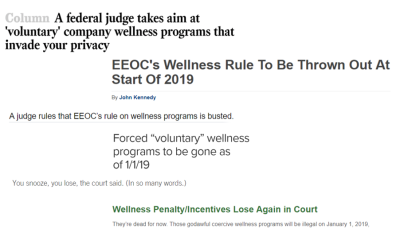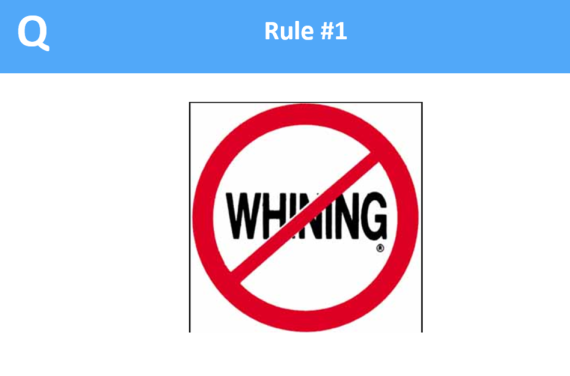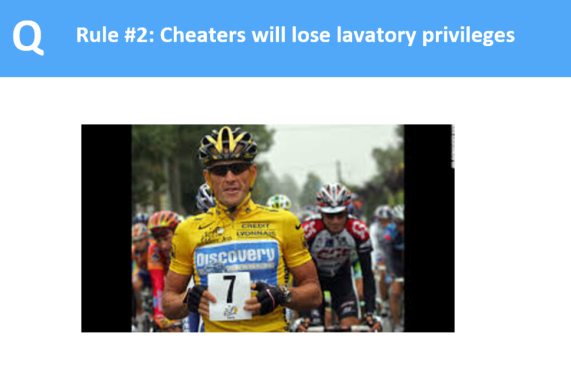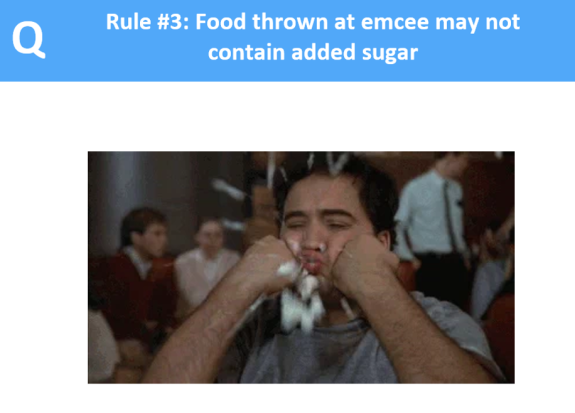OK, this time I’m not the one causing the kerfuffle in the wellness industry, though I will confess to being a force multiplier.
Not since 2014, when the
very unstable morons at the Incidental Economist made fun of the
very stable geniuses who give out the Koop Award and also unequivocally concluded that wellness loses money — combined with continued fallout from the
Penn State debacle and the
Nebraska scandal — has the wellness industry had such a bad year. And it’s only February.
Let’s review what’s happened so far in 2018. First, a federal judge ruled that
voluntary wellness programs need to be — get ready — voluntary. The EEOC’s responded with the legalese equivalent of: “
Fine, be that way.”
Next, Willis Towers Watson did something that might get them in hot water with the very stable wellness industry leaders: They were honest.
They published a study revealing that employees hate wellness even more — way more — than they hate waiting for the cable guy to show up.
Finally, the very unstable National Bureau of Economic Research
conducted a controlled study finding basically no impact whatsoever from a wellness program. More importantly, they specifically invalidated the “pre-post” methodology. Even more importantly, they specifically invalidated 78% of the studies used in Kate Baicker’s “Harvard Study” meta-analysis.
Here is an interesting piece of trivia:
The lead researcher is an assistant professor at the Harris School of Public Policy. Why is this interesting? Because Katherine Baicker — the Typhoid Mary of wellness, whose
THC-infused study claiming a 3.27-to-1 ROI for every dollar invested in wellness is the basis for essentially every subsequent genius wellness outcomes claim —
is now the dean of that very same Harris School. I’m just guessing here, but I’d say it’s gotta be a trifle embarrassing when your own subordinate publicly disproves your own study. I mean, it’s one thing for me,
RAND,
Bloomberg and anyone else with five minutes, internet access and a calculator to do it, but…
your very subordinate?
See also: The Wellness Industry Pleads the Fifth
On the other hand, the researcher, Damon Jones, just demonstrated not just amazing competence but amazing integrity, as well. In other words, he has no future in wellness.
The Wellness Empire Strikes Back
How does the wellness industry respond to these smoking guns threatening their entire revenue stream? Apparently, there is little cause for concern on their planet.

Let’s start with America’s Health Insurance Plans (AHIP), the health insurance industry lobbying group. Here is AHIP’s oxymoronic Wellness Smartbrief (Jan. 26) on the NBER research. Yes, it summarizes the same wellness-emasculating study as the one above, though you could never guess it from the headline:
Healthier employees participate more in wellness programs but still save money
Continuing, AHIP said:
Offering incentives for completing wellness activities might be more cost-effective than offering incentives for wellness screening, a recent study of a comprehensive program found.
Perhaps AHIP has been infiltrated by Russian trolls, because here’s what the NBER article actually said about “completing wellness activities”:
We…do not find any effect of treatment on the number of visits to campus gym facilities or on the probability of participating in a popular annual community running event, two health behaviors that are relatively simple for a motivated employee to change over the course of one year.
AHIP continues:
Wellness programs might attract mostly employees who are already fitness-conscious, but the potential to attract healthy employees whose medical spending is already low could nonetheless be a boon to employers, the researchers found.
And on the subject of “the potential to attract healthy employees” as being a “boon to employers,” the authors actually said:
We further find that selection into wellness programs is associated with both lower average spending and healthier behaviors prior to the beginning of the study. Thus, one motivation for a firm to adopt a wellness program is its potential to screen for workers with low medical spending. Considering only health care costs, reducing the share of non-participating (high-spending) employees by just 4.5 percentage points would suffice to cover the costs of our wellness program intervention.
In other words, you can apply some workplace eugenics to your company by using wellness to weed out obese employees, employees with chronic or congenital diseases and so on. Good for you!
Soon, if AHIP and others have their way, there will be no need for guesswork in eugenics: Employer wellness programs will be able to
screen these employees out based on their actual DNA.
AHIP’s take on AARP v. EEOC
And now, AHIP’s take on this landmark case, their ace reporters scooping everyone with this Feb. 2 headline on the Dec. 20 court ruling:
Employers may have to tweak wellness programs after court ruling
Here are more typical headlines on that court ruling, headlines that came out the same month that the court ruling came out. Perhaps AHIP used the interim six weeks to use focus groups to test various verbs until they settled on…
tweak???
 AHIP: It’s not just the headlines
AHIP: It’s not just the headlines
One prominent healthcare executive recently attended an AHIP conference and reports:
I just returned from one of the dumbest meetings I’ve ever attended in Washington. Report of a new “study” by AHIP. Turns out people don’t mind health costs all that much, they just want more benefits. And everything is hunky-dory with their health plans, people like them so much. They love wellness benefits and crave more. Prescription drug prices have been nicely controlled thanks to the competitive marketplace (no, I am not making this up or exaggerating for drama). For every $1 employers spend on benefits workers get $4 in value. Priorities for SHRM rep: Fitbits for all employees, solving the outrage that only 20% of her employees got an annual physical. 85 cents of every dollar spent on healthcare goes to chronic disease.
Over these same two hours, I’d estimate about a thousand employees were misinformed, harmed or harassed by wellness vendors, roughly equal numbers of employees got useless annual checkups, employers spent about $200 million on healthcare and 40 people died in hospitals from preventable errors. But I’m being such a Debbie Downer! I’m going home to read Why Nobody Believes the Numbers to remove myself from this alternative universe.
Enter the Health Enhancement Research Organization (HERO)
HERO’s Prevaricator-in-Chief, Paul Terry, is demonstrating his usual leadership abilities in this crisis, of course. After all, HERO is the wellness industry trade association, and these three items — the NBER invalidating their product, employees hating their product and a federal judge forbidding them to force employees to use their product — represent existential threats to his “pry, poke and prod” members.
Here
is quite literally his only blog post on any of these three items:
Teddy Roosevelt said, “complaining about a problem without posing a solution is called whining.” It’s a quote that also reminds me why I’ve not thought of angry bloggers who target health promotion [vendors] as bullies. Though they relish trolling for bad apples, their scolding is toothless, more the stuff of chronic whiners.
I suspect he is talking about me here as the “chronic whiner” who is “scolding” them. Or perhaps he is referring to the “angry bloggers” at
the Los Angeles Times, the
New York Times,
Slate or
STATNews, because those “toothless” publications seem to be scolding wellness vendors more than I ever have. For instance, I’ve never called wellness vendors’ offering a “
scam” or a “
sham.” I simply quote these very stable wellness geniuses verbatim, as above or below,
or last week.
See also: Wellness: An Industry Conceived in Lies, Retractions and Hypocrisy
Being quoted verbatim, not angry bloggers, is their worst nightmare. (One thing I would concede, though, is that “Paul Terry and the Angry Bloggers” would be a great name for a rock band.)
Yep, looks like the implosion of his industry is all my fault. Otherwise, I’m not quite sure who is the “angry blogger” he is referring to, other than to note that Mr. Terry himself seems to blog a tad angrily himself, both above, and
here…
Why I choose to ignore the blogger critics: We’re fortunate to work in a profession with a scant number of vociferous critics. My take is that there is one thing these few angry loners [Editor’s note: the complete “scant list” of the 220 “few angry loners” who have been “vociferous critics”
can be found here]
want more desperately than attention: that’s to be taken seriously. What they fail to comprehend is that as they’ve gotten ever more farfetched and vitriolic in search of the former, they’ve cinched their inability to attain the latter.
Baiting people with misinformation and offensive insults (but just a tad under highly offensive) is a pesky ploy that trolls hope will eventually land a bite that confers credibility where there is none. Even reading such drivel is a form of taking the bait; responding is swallowing it whole. Some say dishonesty should not go unchallenged and I respect their view; nevertheless, I’m convinced responding to bloggers who show disdain for our field is an utter waste of time. I’ve rarely been persuaded to respond to bloggers, and each time I did it affirmed my worry that, more than a waste, it’s counter-productive.
…
and especially here, a seemingly incongruous decision to “act out” by someone who claims to be “choosing to ignore the blogger critics.”
Having read years of my “drivel” alongside Mr. Terry’s posting explaining why you shouldn’t “swallow this bait,” perhaps readers might opine here: Which of us, exactly, is the “chronic whiner”?
Coincidentally, when I run live health-and-wellness trivia contests, the first of our three rules is: No Whining. Seems to me that he would have just violated it. Indeed the only rule HERO hasn’t violated so far is #3 below. Not that I want to put ideas in their head.



 Let’s start with America’s Health Insurance Plans (AHIP), the health insurance industry lobbying group. Here is AHIP’s oxymoronic Wellness Smartbrief (Jan. 26) on the NBER research. Yes, it summarizes the same wellness-emasculating study as the one above, though you could never guess it from the headline: Healthier employees participate more in wellness programs but still save money
Continuing, AHIP said:
Offering incentives for completing wellness activities might be more cost-effective than offering incentives for wellness screening, a recent study of a comprehensive program found.
Perhaps AHIP has been infiltrated by Russian trolls, because here’s what the NBER article actually said about “completing wellness activities”:
We…do not find any effect of treatment on the number of visits to campus gym facilities or on the probability of participating in a popular annual community running event, two health behaviors that are relatively simple for a motivated employee to change over the course of one year.
AHIP continues:
Wellness programs might attract mostly employees who are already fitness-conscious, but the potential to attract healthy employees whose medical spending is already low could nonetheless be a boon to employers, the researchers found.
And on the subject of “the potential to attract healthy employees” as being a “boon to employers,” the authors actually said:
We further find that selection into wellness programs is associated with both lower average spending and healthier behaviors prior to the beginning of the study. Thus, one motivation for a firm to adopt a wellness program is its potential to screen for workers with low medical spending. Considering only health care costs, reducing the share of non-participating (high-spending) employees by just 4.5 percentage points would suffice to cover the costs of our wellness program intervention.
In other words, you can apply some workplace eugenics to your company by using wellness to weed out obese employees, employees with chronic or congenital diseases and so on. Good for you!
Soon, if AHIP and others have their way, there will be no need for guesswork in eugenics: Employer wellness programs will be able to screen these employees out based on their actual DNA.
AHIP’s take on AARP v. EEOC
And now, AHIP’s take on this landmark case, their ace reporters scooping everyone with this Feb. 2 headline on the Dec. 20 court ruling:
Employers may have to tweak wellness programs after court ruling
Here are more typical headlines on that court ruling, headlines that came out the same month that the court ruling came out. Perhaps AHIP used the interim six weeks to use focus groups to test various verbs until they settled on…tweak???
Let’s start with America’s Health Insurance Plans (AHIP), the health insurance industry lobbying group. Here is AHIP’s oxymoronic Wellness Smartbrief (Jan. 26) on the NBER research. Yes, it summarizes the same wellness-emasculating study as the one above, though you could never guess it from the headline: Healthier employees participate more in wellness programs but still save money
Continuing, AHIP said:
Offering incentives for completing wellness activities might be more cost-effective than offering incentives for wellness screening, a recent study of a comprehensive program found.
Perhaps AHIP has been infiltrated by Russian trolls, because here’s what the NBER article actually said about “completing wellness activities”:
We…do not find any effect of treatment on the number of visits to campus gym facilities or on the probability of participating in a popular annual community running event, two health behaviors that are relatively simple for a motivated employee to change over the course of one year.
AHIP continues:
Wellness programs might attract mostly employees who are already fitness-conscious, but the potential to attract healthy employees whose medical spending is already low could nonetheless be a boon to employers, the researchers found.
And on the subject of “the potential to attract healthy employees” as being a “boon to employers,” the authors actually said:
We further find that selection into wellness programs is associated with both lower average spending and healthier behaviors prior to the beginning of the study. Thus, one motivation for a firm to adopt a wellness program is its potential to screen for workers with low medical spending. Considering only health care costs, reducing the share of non-participating (high-spending) employees by just 4.5 percentage points would suffice to cover the costs of our wellness program intervention.
In other words, you can apply some workplace eugenics to your company by using wellness to weed out obese employees, employees with chronic or congenital diseases and so on. Good for you!
Soon, if AHIP and others have their way, there will be no need for guesswork in eugenics: Employer wellness programs will be able to screen these employees out based on their actual DNA.
AHIP’s take on AARP v. EEOC
And now, AHIP’s take on this landmark case, their ace reporters scooping everyone with this Feb. 2 headline on the Dec. 20 court ruling:
Employers may have to tweak wellness programs after court ruling
Here are more typical headlines on that court ruling, headlines that came out the same month that the court ruling came out. Perhaps AHIP used the interim six weeks to use focus groups to test various verbs until they settled on…tweak???
 AHIP: It’s not just the headlines
One prominent healthcare executive recently attended an AHIP conference and reports:
I just returned from one of the dumbest meetings I’ve ever attended in Washington. Report of a new “study” by AHIP. Turns out people don’t mind health costs all that much, they just want more benefits. And everything is hunky-dory with their health plans, people like them so much. They love wellness benefits and crave more. Prescription drug prices have been nicely controlled thanks to the competitive marketplace (no, I am not making this up or exaggerating for drama). For every $1 employers spend on benefits workers get $4 in value. Priorities for SHRM rep: Fitbits for all employees, solving the outrage that only 20% of her employees got an annual physical. 85 cents of every dollar spent on healthcare goes to chronic disease.
Over these same two hours, I’d estimate about a thousand employees were misinformed, harmed or harassed by wellness vendors, roughly equal numbers of employees got useless annual checkups, employers spent about $200 million on healthcare and 40 people died in hospitals from preventable errors. But I’m being such a Debbie Downer! I’m going home to read Why Nobody Believes the Numbers to remove myself from this alternative universe.
Enter the Health Enhancement Research Organization (HERO)
HERO’s Prevaricator-in-Chief, Paul Terry, is demonstrating his usual leadership abilities in this crisis, of course. After all, HERO is the wellness industry trade association, and these three items — the NBER invalidating their product, employees hating their product and a federal judge forbidding them to force employees to use their product — represent existential threats to his “pry, poke and prod” members.
Here is quite literally his only blog post on any of these three items:
Teddy Roosevelt said, “complaining about a problem without posing a solution is called whining.” It’s a quote that also reminds me why I’ve not thought of angry bloggers who target health promotion [vendors] as bullies. Though they relish trolling for bad apples, their scolding is toothless, more the stuff of chronic whiners.
I suspect he is talking about me here as the “chronic whiner” who is “scolding” them. Or perhaps he is referring to the “angry bloggers” at the Los Angeles Times, the New York Times, Slate or STATNews, because those “toothless” publications seem to be scolding wellness vendors more than I ever have. For instance, I’ve never called wellness vendors’ offering a “scam” or a “sham.” I simply quote these very stable wellness geniuses verbatim, as above or below, or last week.
See also: Wellness: An Industry Conceived in Lies, Retractions and Hypocrisy
Being quoted verbatim, not angry bloggers, is their worst nightmare. (One thing I would concede, though, is that “Paul Terry and the Angry Bloggers” would be a great name for a rock band.)
Yep, looks like the implosion of his industry is all my fault. Otherwise, I’m not quite sure who is the “angry blogger” he is referring to, other than to note that Mr. Terry himself seems to blog a tad angrily himself, both above, and here…
Why I choose to ignore the blogger critics: We’re fortunate to work in a profession with a scant number of vociferous critics. My take is that there is one thing these few angry loners [Editor’s note: the complete “scant list” of the 220 “few angry loners” who have been “vociferous critics” can be found here] want more desperately than attention: that’s to be taken seriously. What they fail to comprehend is that as they’ve gotten ever more farfetched and vitriolic in search of the former, they’ve cinched their inability to attain the latter.
Baiting people with misinformation and offensive insults (but just a tad under highly offensive) is a pesky ploy that trolls hope will eventually land a bite that confers credibility where there is none. Even reading such drivel is a form of taking the bait; responding is swallowing it whole. Some say dishonesty should not go unchallenged and I respect their view; nevertheless, I’m convinced responding to bloggers who show disdain for our field is an utter waste of time. I’ve rarely been persuaded to respond to bloggers, and each time I did it affirmed my worry that, more than a waste, it’s counter-productive.
…and especially here, a seemingly incongruous decision to “act out” by someone who claims to be “choosing to ignore the blogger critics.”
Having read years of my “drivel” alongside Mr. Terry’s posting explaining why you shouldn’t “swallow this bait,” perhaps readers might opine here: Which of us, exactly, is the “chronic whiner”?
Coincidentally, when I run live health-and-wellness trivia contests, the first of our three rules is: No Whining. Seems to me that he would have just violated it. Indeed the only rule HERO hasn’t violated so far is #3 below. Not that I want to put ideas in their head.
AHIP: It’s not just the headlines
One prominent healthcare executive recently attended an AHIP conference and reports:
I just returned from one of the dumbest meetings I’ve ever attended in Washington. Report of a new “study” by AHIP. Turns out people don’t mind health costs all that much, they just want more benefits. And everything is hunky-dory with their health plans, people like them so much. They love wellness benefits and crave more. Prescription drug prices have been nicely controlled thanks to the competitive marketplace (no, I am not making this up or exaggerating for drama). For every $1 employers spend on benefits workers get $4 in value. Priorities for SHRM rep: Fitbits for all employees, solving the outrage that only 20% of her employees got an annual physical. 85 cents of every dollar spent on healthcare goes to chronic disease.
Over these same two hours, I’d estimate about a thousand employees were misinformed, harmed or harassed by wellness vendors, roughly equal numbers of employees got useless annual checkups, employers spent about $200 million on healthcare and 40 people died in hospitals from preventable errors. But I’m being such a Debbie Downer! I’m going home to read Why Nobody Believes the Numbers to remove myself from this alternative universe.
Enter the Health Enhancement Research Organization (HERO)
HERO’s Prevaricator-in-Chief, Paul Terry, is demonstrating his usual leadership abilities in this crisis, of course. After all, HERO is the wellness industry trade association, and these three items — the NBER invalidating their product, employees hating their product and a federal judge forbidding them to force employees to use their product — represent existential threats to his “pry, poke and prod” members.
Here is quite literally his only blog post on any of these three items:
Teddy Roosevelt said, “complaining about a problem without posing a solution is called whining.” It’s a quote that also reminds me why I’ve not thought of angry bloggers who target health promotion [vendors] as bullies. Though they relish trolling for bad apples, their scolding is toothless, more the stuff of chronic whiners.
I suspect he is talking about me here as the “chronic whiner” who is “scolding” them. Or perhaps he is referring to the “angry bloggers” at the Los Angeles Times, the New York Times, Slate or STATNews, because those “toothless” publications seem to be scolding wellness vendors more than I ever have. For instance, I’ve never called wellness vendors’ offering a “scam” or a “sham.” I simply quote these very stable wellness geniuses verbatim, as above or below, or last week.
See also: Wellness: An Industry Conceived in Lies, Retractions and Hypocrisy
Being quoted verbatim, not angry bloggers, is their worst nightmare. (One thing I would concede, though, is that “Paul Terry and the Angry Bloggers” would be a great name for a rock band.)
Yep, looks like the implosion of his industry is all my fault. Otherwise, I’m not quite sure who is the “angry blogger” he is referring to, other than to note that Mr. Terry himself seems to blog a tad angrily himself, both above, and here…
Why I choose to ignore the blogger critics: We’re fortunate to work in a profession with a scant number of vociferous critics. My take is that there is one thing these few angry loners [Editor’s note: the complete “scant list” of the 220 “few angry loners” who have been “vociferous critics” can be found here] want more desperately than attention: that’s to be taken seriously. What they fail to comprehend is that as they’ve gotten ever more farfetched and vitriolic in search of the former, they’ve cinched their inability to attain the latter.
Baiting people with misinformation and offensive insults (but just a tad under highly offensive) is a pesky ploy that trolls hope will eventually land a bite that confers credibility where there is none. Even reading such drivel is a form of taking the bait; responding is swallowing it whole. Some say dishonesty should not go unchallenged and I respect their view; nevertheless, I’m convinced responding to bloggers who show disdain for our field is an utter waste of time. I’ve rarely been persuaded to respond to bloggers, and each time I did it affirmed my worry that, more than a waste, it’s counter-productive.
…and especially here, a seemingly incongruous decision to “act out” by someone who claims to be “choosing to ignore the blogger critics.”
Having read years of my “drivel” alongside Mr. Terry’s posting explaining why you shouldn’t “swallow this bait,” perhaps readers might opine here: Which of us, exactly, is the “chronic whiner”?
Coincidentally, when I run live health-and-wellness trivia contests, the first of our three rules is: No Whining. Seems to me that he would have just violated it. Indeed the only rule HERO hasn’t violated so far is #3 below. Not that I want to put ideas in their head.











